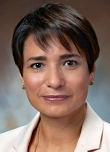How EMD Serono Is Bringing Diverse Patient Voices Together
By Maria Rivas, M.D., chief medical officer and SVP of Global Medical Affairs and Global Evidence and Value Development, EMD Serono

Across the healthcare community, there’s a known disparity in clinical care for underrepresented populations, such as minorities and women.1 These disparities have been further underscored by the COVID-19 pandemic, where the most pervasive ones have been observed with African Americans and Latinos.2
The pandemic has created an opportunity to address some of the causes underlying these inequities.3 And while combatting these issues will take time, much can be done by first addressing the gap for minorities in clinical trials. This is a topic I am passionate about both personally and professionally as a female Hispanic chief medical officer.
Clinical trial participants play a critical role in helping scientists find future treatment options, and data on the effects of investigational drugs on all populations are vitally needed to help physicians and patients make informed decisions on the best course of therapy. However, encouraging patients to enroll in these clinical trials has been a barrier for many years.
The rate of trial participation has not changed substantially over time, with patient-related barriers often cited. 4 Take for example that, the vast majority of adult cancer patients (>95 percent) do not participate in clinical trials, even though 70 percent of Americans are estimated to be inclined or very willing to participate in clinical trials.5
In recent years, companies have begun to pay closer attention to the patient perspective in clinical trials in an effort to address these hurdles. Take, for example, my company, EMD Serono, —and our collaboration on a first-of-its-kind initiative to incorporate the voice of the patient into multiple sclerosis (MS) clinical trials. We established the project in partnership with Accelerated Cure Project (ACP) for MS and support it through iConquerMS, a people-powered research initiative of the ACP. The project offered an unprecedented level of engagement for patients in designing MS clinical trials and laid the groundwork for other companies to employ a patient-directed model in research and trial designs.
Despite these important strides both at our company and beyond, clinical trial barriers remain a challenge, and, specifically, representation of racial minorities, ethnic minorities, and women in U.S. clinical trials remains insufficient. This creates significant challenges for the healthcare industry, as clinical research inclusion of all populations is crucial to bridging the care gap.
According to a recent study conducted by the Center for the Study of Drug Development at the Tufts University School of Medicine, minority patients, most notably those of Black and African descent, are the most underrepresented subgroup for clinical trials, with participation rates registering 65 percent below their levels in general census and disease populations.6 Tufts’ research also shows that patient referral rates into clinical trials by minority physicians and nurses are very low.
Learnings from our ACP partnership have helped EMD Serono make strides in diversifying our clinical trials in lupus, a disease that disproportionately impacts African American women. However, we acknowledge that there is still opportunity for improvement in the representation of minority populations in our clinical trials and those across the industry.
As a company and as individuals, we have asked ourselves several questions to help us improve: How do we ensure an equitable approach to the inclusion of patients from diverse backgrounds? How do we embrace diversity and inclusion across the clinical trial ecosystem through our clinical trial sites and investigators? What elements of our research design may inadvertently create hurdles to clinical trial participation by patients from diverse backgrounds? We don’t have all the answers, but we know that our efforts need to begin with the patient in mind — and to develop the best treatment options for our patients, we need optimal clinical research approaches.
To start driving this change within EMD Serono, we’ve held a patient journey workshop with patients from minority groups, where we explored barriers to clinical trial participation in their communities, evaluated the ease of understanding of our clinical trial recruitment materials, and asked about the preferred channels to learn about clinical trials. This feedback has been instrumental in improving recruitment of minority patients to our clinical studies, as we update patient materials and expand the channels for our digital recruitment.
Further, collaboration with study teams, patients, and advocacy groups is vital. Within our Global Clinical Operations team, we work closely with advocacy groups to host advisory boards to gather feedback directly from patients and physicians. We apply learnings from these events to enhance the design of our studies with a patient-centric mindset. Among the groups we have worked with are the Lupus Research Alliance and the Lupus Foundation of America.
Additionally, we have joined and sponsored global clinical development workshops with a focus on minority populations in clinical trials. In these workshops, we have had representation from academia and subject matter experts in a specific disease area. Discussions during these events highlighted trust issues in the community, underscoring the importance of empathetic and culturally sensitive communication between industry and underrepresented communities. In response to these learnings, we are applying new standards for interaction with patients and carefully developing site selection and recruitment strategies ahead of the launch of any new clinical trial. These efforts include using “easy to understand” language in patient communication materials; selecting a broader set of well-distributed, qualified clinical trial sites; and leveraging community outreach directly rather than using only communication channels available to the clinical trial sites.
Beyond the collaborations we have established, we are also active members of organizations driving toward greater inclusion in clinical research. One of these organizations is the Clinical Transformation Trials Initiative (CTTI), an organization working to drive the adoption of practices that will increase the quality and efficiency of clinical trials. Our Clinical Innovation group represents EMD Serono as part of CTTI’s Increasing Diversity in Clinical Trials project, which is working to create evidence-based recommendations to sponsors, regulatory agencies, and advocacy groups to increase the participation of minorities in clinical trials.
This is a good start, but our efforts do not stop there. We are taking important steps to identify the best ways to collaborate with minority and underrepresented patients to educate communities about clinical trial participation. EMD Serono continues to be an active member of the Center for Information & Study on Clinical Research Participation (CISCRP), a nonprofit organization dedicated to increasing awareness about clinical research among the general population and patients. As a key sponsor, we’ve had the privilege to be directly involved in CISCRP’s AWARE for All campaign. This campaign consists of hosting multiple conferences throughout the year in cities with high prevalence of minority populations. The AWARE for All events focus on educating attendees on the clinical trial process, and as part of this program, we have focused our efforts on actively raising awareness and improving clinical research literacy. Since our participation as a National Sponsor in 2013, more than 2 million people have received educational materials about clinical research through print and electronic outreach. Our hope is that by starting to more broadly educate the public, we’ll identify new ways to reach minorities.
As a company, we have made some progress, but we still need to do more. In the pharmaceutical industry, we need to be open to exploring our own biases and weaknesses so we can put an improved clinical trial infrastructure in place to optimize treatment for patients across all walks of life and work to close treatment gaps. As we continue to collaborate with others across the industry, we hope to share learnings and identify new ways to improve diversity within our clinical trials. At the end of the day, it isn’t just about making things fair; diversity is about doing the best we can for ALL patients.
References:
- Tufts CSDD Impact Report May/June 2020, Vol. 22, No. 3, Tufts Center for the Study of Drug Development Establishes Demographic Benchmarks for Pivotal Clinical Trials, Showing Areas of Under-Representation. Accessed May 28, 2020. https://csdd.tufts.edu/csddnews
- Hooper, MW et al. COVID-19 and Racial/Ethnic Disparities. JAMA. 2020;323(24):2466-2467. https://jamanetwork.com/journals/jama/fullarticle/2766098
- Hooper, MW et al. COVID-19 and Racial/Ethnic Disparities. JAMA. 2020;323(24):2466-2467. https://jamanetwork.com/journals/jama/fullarticle/2766098
- Unger, J. et al. Role of Clinical Trial Participation in Cancer Research: Barriers, Evidence, and Strategies. ASCO Educational Book. 2016; 35: 185-198. https://www.ncbi.nlm.nih.gov/pmc/articles/PMC5495113/
- Unger, J. et al. Role of Clinical Trial Participation in Cancer Research: Barriers, Evidence, and Strategies. ASCO Educational Book. 2016; 35: 185-198. https://www.ncbi.nlm.nih.gov/pmc/articles/PMC5495113/
- Tufts CSDD Impact Report May/June 2020, Vol. 22, No. 3, Tufts Center for the Study of Drug Development Establishes Demographic Benchmarks for Pivotal Clinical Trials, Showing Areas of Under-Representation. Accessed May 28, 2020. https://csdd.tufts.edu/csddnews
About The Author:
 Maria Rivas, MD, is chief medical officer and SVP of Global Medical Affairs and Global Evidence and Value Development at EMD Serono, the biopharmaceutical business of Merck KGaA, Darmstadt, Germany in the U.S. She is responsible for developing and successfully implementing a world-class medical affairs and value evidence strategy, to improve the healthcare ecosystem and positively impact the lives of patients. You can connect with her on LinkedIn.
Maria Rivas, MD, is chief medical officer and SVP of Global Medical Affairs and Global Evidence and Value Development at EMD Serono, the biopharmaceutical business of Merck KGaA, Darmstadt, Germany in the U.S. She is responsible for developing and successfully implementing a world-class medical affairs and value evidence strategy, to improve the healthcare ecosystem and positively impact the lives of patients. You can connect with her on LinkedIn.
